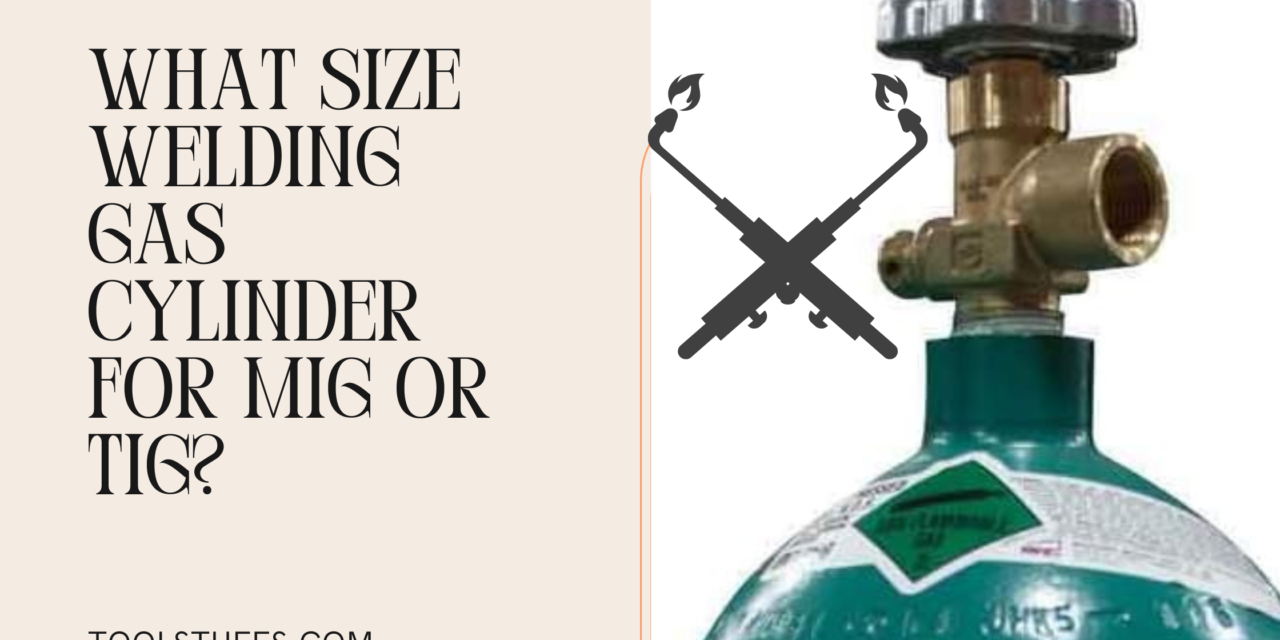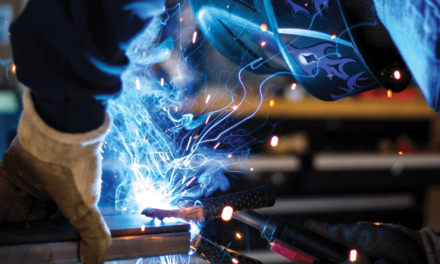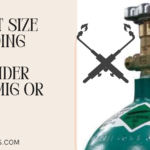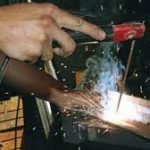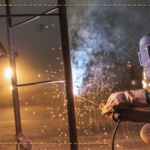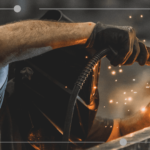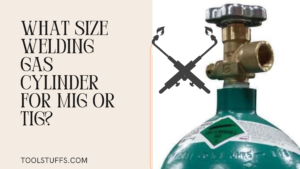
Before starting MIG and TIG welding, a welder has to first figure out how much gas to fill their welding cylinder with. Having to fill up your gas tank daily is a chore no one looks forward to.
However, these huge tanks may be troublesome to relocate and store. Welders should be aware of the differences in fuel capacity between the various types of tanks.
If you’ve never done any MIG or TIG welding before, you have no idea how much welding you’ll do, much less how much welding gas you’ll need.
It would be helpful to know how long a bottle of welding gas would last before deciding on a welding tank size, though.
I’ll go through the different sizes and types of welding bottles available so that you may select the best one for your welding endeavors. I’ll also explain factors to consider when choosing cylinder Size.
Let’s explore more!
Table of Contents
Gases That Are Typically Used When Welding
Oxygen, carbon monoxide (CO2), helium, and argon are some of the most commonly used welding gases. Although some gases, such as Argon, can be used alone, it is more common to utilize a mix, which is a blend of several gases.
Some of the most often encountered gas combinations, along with their typical applications, are as follows:
-
Argon:
It is usual practice to utilize the gas alone when welding aluminum and magnesium, two non-ferrous metals. TIG welding is another common use.
-
75% Argon, 25% Carbon Dioxide:
Because it produces a steady arc, this is a go-to welding mild steel blend. However, it can be used to weld stainless steel, but not well.
-
5% Carbon Dioxide + 10% Argon + 85% Helium:
Because Helium helps keep the metal from oxidizing or rusting, this combination is frequently utilized in stainless steel.
-
Helium and Argon:
Argon and Helium, in various proportions, may be utilized to weld non-ferrous metals of significantly greater thickness. Although welding with pure Argon is possible, it is not recommended for thicker pieces of material. The use of Helium increases the arc’s temperature, allowing for the welding of thicker metals.
Standard Welding Gas Bottle Sizes for MIG and TIG Welding
Welders typically use welding gas tank sizes of 40, 80, or 125 cubic feet (cf) of MIG mixes or Argon gas for TIG; however, these sizes are not the only ones available.
The bigger tank gives you more weld time between refills since it holds 125 cf. It’s heavier and longer than most people are comfortable lifting, yet most people can still easily maneuver it from place to place.
The smaller 40cf bottle is convenient for off-site work or for people who don’t require a lot of welding gas because it can be carried in one hand.
The 80cf cylinder size is the sweet spot between long duration and portability for most occasional welders.
Common Argon and CO2 Tank Sizes for MIG OR TIG

With both MIG and TIG welding, common argon bottle sizes range from 20 to 40 cubic feet for lighter-duty applications and 80 to 125 cubic feet for professional and industrial use.
Since CO2 is consumed at a higher rate than argon tank sizes, the tank sizes are comparable but typically larger to accommodate this.
Whether you go with a smaller, more easily transportable cylinder or a larger, more stationary supply depends on your welding needs and the available space.
Factors to Consider when Selecting the Appropriate Cylinder Size:
-
Welding Frequency:
The amount of the gas cylinder you require is mostly dependent on how often you execute welding activities. Larger cylinders are necessary to maintain a steady supply of gas without regular refills if you are a professional welder or frequently work on large-scale projects. On the other hand, infrequent or hobby welders may prefer smaller cylinders because of the higher cost and increased maintenance requirements.
-
Amount of Gas Use:
Your welding method, the thickness of the material, and the type of gas you are using all affect how quickly it will burn through. For instance, MIG welding with a greater CO2 component tends to use more gas than TIG welding with pure Argon. As a result, you must determine your gas consumption rate according to your individual welding requirements.
-
Size Options for Gas Cylinders:
Cylinders for storing gas range in size from a few liters to hundreds of cubic feet. The most common sizes are 20, 40, 80, 125, and 300 cubic feet. Cylinders come in a variety of sizes, with the bigger ones meant for more permanent installations like welding.
-
Space and Portability:
Think about how much room you have in your garage or welding shed, and how convenient it will be to move the gas cylinders about. Although smaller cylinders are more convenient to transport and store, they may need to be refilled more frequently. Larger cylinders provide more gas for a longer period of time but are more difficult to transport.
-
Rates, Refills, and Alternatives:
The initial investment in a gas cylinder varies according to its size and the type of gas it contains. The price of gas refills or swaps is something else to think about. While smaller cylinders may be less expensive initially, they may end up costing more owing to increased refill frequency. If you have a lot of welding to do, you’ll probably get more bang for your buck if you get a larger cylinder.
MIG/TIG Welding Gas Tank Specifications | Argon and MIG blends
The table below displays the parameters for TIG welding and MIG welding gas mixtures. You’ll be able to determine the ideal gas tank capacity with more precision. The cylinders are frequently marked with a lettering scheme that also indicates the size of the cylinder.
| Size | 40 cf (#2/V) | 80 cf (#3/Q) | 125 cf (#4/D) |
|---|---|---|---|
| Height | 22 in. | 35 in. | 45 in. |
| Diameter | 6½ – 7¼ in. | 6½ – 7¼ in. | 6½ – 7¼ in. |
| Empty Weight | 24 lbs | 47 lbs | 58 lbs |
| Full Weight | 28 lbs | 56 lbs | 71 lbs |
| Full Pressure | 2015 PSI | 2015 PSI | 2265 PSI |
The sizes and weights given are all approximations. Talk to the vendor to get all the specifics.
If you’re unsure if the gas cylinder size you want will fit in the space, it’s best to be safe and get other opinions. The cylinder diameters you’re interested in may not be supported by your welding cart. The welding cart should not be overloaded. A larger cart should be used if the cylinders cannot fit. One helpful hint is to contact your local gas provider to find out the recommended size. They know all about the ins and outs of gas distribution and the weather and storage laws in your region. Consider this while you shop for a welding gas tank.
Common Tanks for MIG Welding
Common tanks or cylinders used for MIG (Metal Inert Gas) welding typically contain a mixture of gases suitable for shielding the welding arc and protecting the weld pool from atmospheric contamination. The most common tanks for MIG welding are:
| Image | Product Name | Latest Price |
 | 80 cu/ft 75% Argon 25% CO2 Welding Gas Cylinder Tank | |
 | 125 cu/ft 75% Argon 25% CO2 Welding Gas Cylinder Tank | |
 | 40 cu/ft 75% Argon 25% CO2 Welding Gas Cylinder Tank |
Argon tanks for TIG
Argon tanks for TIG (Tungsten Inert Gas) welding come in various sizes to accommodate different welding needs. Here are some of the best possible choices:
| Image | Product Name | Latest Price |
 | 40 cu/ft 100% Argon Welding Gas Cylinder Tank | |
 | 80 cu/ft 100% Argon Cylinder Tank Welding Gas | |
 | 125 cu/ft 100% Argon Tank Welding Gas Cylinder |
A Few Words about Small Tanks
The main reason why professional welders look down on small tanks is because they are difficult to work with. This is understandable, considering the inconvenient reality that smaller tanks tend to run out of gas easily.
Many professional welders find 20CF and 40CF to be too small, despite the fact that they are lightweight and convenient to transport. But they aren’t completely useless; in fact, they’re quite popular among amateur welders. When paired with an inverter welder, those smaller tanks become the ideal portable setup.
Using 100% CO2 Gas Cylinders for MIG
Sometimes MIG welders prefer to use pure carbon dioxide as their shielding gas. It’s not ideal, but it does have certain advantages, such as cheaper operational expenses and more market penetration.
When using this shielding gas for MIG welding, the arc will be less steady. When welding thin metal, more sparks and drops will be ejected from the weld pool, and the deeper penetration might be problematic.
In Conclusion
Having all the necessary dimensions and specs makes getting a welding gas tank effortless. If you have questions beyond these or relating to safety procedures, you should call your local gas provider. They’ll do anything they can to help you out.
Choose a tank that can be readily refilled, or choose one that is prefilled in your region. We hope this information was useful in deciding which gas cylinder to use for your upcoming project.

